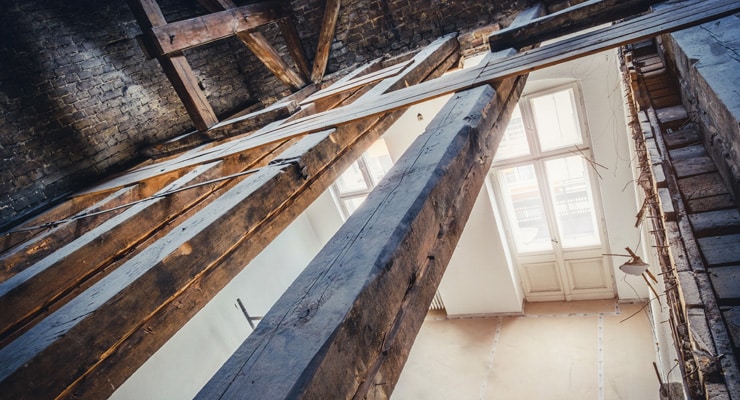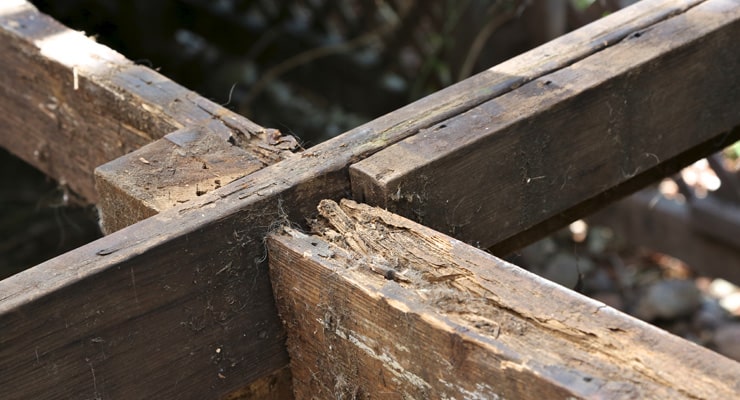Selling Problem Properties: How to Sell a House with Dry Rot
If your house has dry rot it can literally be a rotten problem to have. Dry rot can cost you a lot of money. It can knock thousands of pounds off the value of your house and even make it impossible to sell your property. Here’s our simple guide to dry rot, how to solve it, and how to sell your house quickly for cash even if it has dry rot.

Contents
- What is Dry Rot?
- The Causes
- The Tell-Tale Signs
- What does Dry Rot Look Like?
- What Does Dry Rot Smell Like?
- How Serious is It?
- Dry Rot Spores
- Dry Rot and Wet Rot - The Difference
- How to Prevent It
- Treatment
- How Much does it Cost to Fix Dry Rot?
- Is Dry Rot Covered by Home Insurance?
- Selling a House with Dry Rot
What is Dry Rot?
Dry rot is a naturally occurring fungus that causes timber to rot. Dry rot fungus uses damp timber as its food base to help it develop and spread.
The most common household dry rot fungus is a brown rot fungus known as Serpula lacrymans or S. lacrymans for short.
Serpula lacrymans is said to be the most damaging destroyer of indoor wood construction materials in the UK.
While dry rot only actually destroys timber it can spread to other building materials such as brick, stone, plaster and even steel.
The Causes
Dry rot is caused when some wood is exposed to damp. Dry rot can be caused if your house has such problems as a leaking roof, broken or blocked gutters, leaking pipes or drains, a condensation problem, a faulty or no damp proof course or is subject to flooding.
Dry rot can occur in timber with a moisture content of more than 20% or so. Dry rot grows and spreads fast in timber with a moisture content of 30-40% or so.

Sell Your Investment Property in Days
Any condition, tenanted or vacant, for it’s full market value. Offers in 3-5 days. No sale, no fee.
The Tell-Tale Signs
Here are the main symptoms of dry rot:
- An unpleasant smell. If your home smells damp, smells musty, or has a ‘mushroomy’ smell then you may have dry rot.
- The presence of dry rot growth. Dry rot growth is white/grey and fluffy in nature.
Dry rot fungus spreads through what is known as mycelium growth, which is made up of branching filaments known as hypha. Mycelium growth is one of the early stages of dry rot development. It can spread several millimetres every day. - The presence of fungal growth. The fungal growth of Serpula lacrymans is a rusty red or orange sponge-like structure made up of what are known as fruiting bodies or sporophores. This fungal growth occurs in the later stages of dry rot when the fruiting bodies release spores which settle on and infect more timber.
- The appearance of the timber. Timber affected by dry rot is dark in colour and appears to be dried out, hence the name. It is cracked or broken up with what is known as cuboidal cracking.
What does Dry Rot Look Like?
A big problem with dry rot is that occurs in out-of-the-way and hidden places, so it’s not always easy to see the signs of dry rot.
Here are some photos showing what dry rot looks like:
Mycelium Growth

Fungus

Affected Timber

What Does Dry Rot Smell Like?
Dry rot has a range of smells, depending on the variant and of course, depending on who you ask. People mostly agree that it has an almost earthy smell while many also describe it as smelling like mushrooms. While the smell is unpleasant, breathing in the odour isn't particularly harmful although the damp conditions needed for rot to spread can be bad for elderly people, children and those with respiratory conditions. Also, there may be other fungi present, with more harmful spores.
The smell is unpleasant and will grow stronger as the dry rot spreads. And in many senses, this is a good thing, in that as the problem worsens, your chance of missing it decreases with the intensifying smell.
How Serious is It?
A serious case of dry rot can be very serious indeed. The worst-case scenario is that dry rot can affect the structural integrity of your home, making major rebuilding work necessary. There has been at least one case where part of a building collapsed due to dry rot and resulted in fatalities.
Although most cases of dry rot are not as bad as this they all have the potential to become serious because of the rate at which dry rot spreads.
Dry Rot Spores
Dry rot starts as microscopic spores which spread through the timber of your property. When they encounter the correct conditions they start to grow long white strands known as hyphae and as the hyphae germinate a mycelium mass is created. On their own and in large enough quantities the dry rot spores are fine orange dust, though you would be unlikely to ever see something like this.
The spores themselves are not harmful but the conditions they thrive in can be.
Dry Rot and Wet Rot - The Difference
The term ‘dry rot’ arises because wood affected by dry rot appears dry, even though it has been caused by damp. Timber affected by wet rot appears wet and is soft and spongy in appearance.
Both dry rot and wet rot are caused by a fungus, but different types. Wet rot fungus tends to be black, white or yellow in colour rather than the rusty red or orange colouring of dry rot.
The key difference between dry and wet rot is the moisture content needed to cause them. Wet rot occurs when the timber moisture content exceeds 50% compared to 20% for dry rot.
Wet rot doesn’t spread in the same way as dry rot and will stop when the moisture content falls below 50%.
Here’s more from RICS on how to tell the difference between dry rot and wet rot.
How to Prevent It
Dry rot can be prevented by:
- Checking the outside of your home periodically for problems. For example, look for broken or slipped roof tiles, missing pointing to roofs, chimneys and walls, damaged lead flashings, blocked or leaking gutters and leaking pipes.
- Checking the inside of your home periodically for damp. For example, check ceilings and walls, including behind furniture and in cupboards, cellars and in the loft or attic.
- Ensuring that your home is dry and well ventilated. Aim to minimise or eliminate condensation on windows and other surfaces.

Sell Your Investment Property in Days
Any condition, tenanted or vacant, for it’s full market value. Offers in 3-5 days. No sale, no fee.
Treatment
If you suspect you have dry rot then the best course of action is to take advice from a surveyor or a specialist dry rot treatment company.
You can find details of specialist dry rot treatment companies from The Property Care Association.
A surveyor or specialist dry rot treatment company will undertake a dry rot survey. They will be able to properly diagnose your dry rot and create a treatment plan for it.
The successful treatment of dry rot is likely to involve:
- Establishing the original cause of the dry rot and fixing it. For example, a roof leak.
- Drying out the affected area to ensure the dry rot cannot return. For example, by providing proper damp proofing and good ventilation.
- Treating and replacing timber and other building materials that have been affected by dry rot. This could involve cutting out and replacing timber that is affected and spraying the affected area with a fungicide.
How Much does it Cost to Fix Dry Rot?
The cost of fixing dry rot depends on how extensive it is. According to AXA, every single occurrence of dry rot will cost at least £1,000-£2,000 plus the cost of building repairs on top. However, a more extensive case could cost £20,000 to fix.
Is Dry Rot Covered by Home Insurance?
In most cases, dry rot isn’t covered by house insurance on a standard household insurance policy. Most home insurance policies have a clause which specifically excludes dry rot.
Insurance companies may cover dry rot that has been caused by something else that is insured, such as a flood or burst pipe, but no more than that.
Selling a House with Dry Rot
The big problem with dry rot is that it decreases the value of your property. Dry rot can knock thousands of pounds off the value of your house. Dry rot could mean that you will have to make expensive repairs before you can sell your house.
Dry rot and mortgages: The really big problem with dry rot is that it can make your house unmortgageable and so unsaleable.
When you sell your house, a buyer’s surveyor will check for dry rot and the signs of dry rot, as well as other serious problems. If dry rot is seen or suspected he or she will note this in the Homebuyer’s Report or valuation survey.
Once your buyer finds out about the dry rot chances are they will reduce their offer or pull out and the sale will fall through.
If dry rot is reported in the survey it is likely that the bank or building society will only offer the buyer a reduced mortgage, will only give a mortgage once the dry rot has been cured, or won’t give a mortgage on the property at all. This would mean that no one buying with a mortgage will be able to buy your house.
So, if your house has dry rot you could look at fixing the problem before putting it onto the market. Obtain some quotes to find out how expensive it will be.
But there is a way to successfully sell your dry rot affected house without having to fix it first. This is to sell it directly to a cash buyer.
If you sell to a cash buyer they won’t need a mortgage and so a bank or building society won’t be able to delay or stop the sale. The cash buyer will be able to offer you a fixed cash price and guaranteed completion. Your house will be sold, the cash will be in the bank and your dry rot problem solved within a few short weeks.



